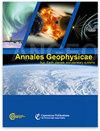The Lehtinen–Pirjola method modified for efficient modelling of geomagnetically induced currents in multiple voltage levels of a power network
IF 1.9
4区 地球科学
Q3 ASTRONOMY & ASTROPHYSICS
引用次数: 2
Abstract
Abstract. The need for accurate assessment of the geomagnetic hazard to power systems is driving a requirement to model geomagnetically induced currents (GIC) in multiple voltage levels of a power network. The Lehtinen–Pirjola method for modelling GIC is widely used but was developed when the main aim was to model GIC in only the highest voltage level of a power network. Here we present a modification to the Lehtinen–Pirjola (LP) method designed to provide an efficient method for modelling GIC in multiple voltage levels. The LP method calculates the GIC flow to ground from each node. However, with a network involving multiple voltage levels, many of the nodes are ungrounded, i.e. have infinite resistance to ground, which is numerically inconvenient. The new modified Lehtinen–Pirjola (LPm) method replaces the earthing impedance matrix [Ze] with the corresponding earthing admittance matrix [Ye] in which the ungrounded nodes have zero admittance to ground. This is combined with the network admittance matrix [Yn] to give a combined matrix ([Yn] + [Ye]), which is a sparse symmetric positive definite matrix allowing efficient techniques, such as Cholesky decomposition, to be used to provide the nodal voltages. The nodal voltages are then used to calculate the GIC in the transformer windings and the transmission lines of the power network. The LPm method with Cholesky decomposition also provides an efficient method for calculating GIC at multiple time steps. Finally, the paper shows how software for the LP method can be easily converted to the LPm method and provides examples of calculations using the LPm method.改进的Lehtinen-Pirjola方法可以有效地模拟电网中多个电压水平的地磁感应电流
摘要为了准确评估地磁对电力系统的危害,需要在电网的多个电压水平下建立地磁感应电流(GIC)模型。Lehtinen-Pirjola方法是一种被广泛使用的模型,但它的发展主要是为了在电网的最高电压水平上对GIC进行建模。本文提出了一种改进的Lehtinen-Pirjola (LP)方法,旨在为多电压水平下的GIC建模提供一种有效的方法。LP方法计算从每个节点到地的GIC流。然而,在涉及多个电压等级的网络中,许多节点是不接地的,即对地电阻无穷大,这在数值上是不方便的。新的改进Lehtinen-Pirjola (LPm)方法将接地阻抗矩阵[Ze]替换为相应的接地导纳矩阵[Ye],其中不接地节点对地导纳为零。这与网络导纳矩阵[Yn]相结合,得到一个组合矩阵([Yn] + [Ye]),这是一个稀疏对称正定矩阵,允许使用有效的技术,如Cholesky分解,来提供节点电压。节点电压然后用于计算变压器绕组和电网传输线中的GIC。具有chooleskydecomposition的LPm方法也为计算多时间步长的GIC提供了一种有效的方法。最后,本文说明了如何将LP方法的软件很容易地转换为LPm方法,并提供了使用LPm方法的计算实例。
本文章由计算机程序翻译,如有差异,请以英文原文为准。
求助全文
约1分钟内获得全文
求助全文
来源期刊

Annales Geophysicae
地学-地球科学综合
CiteScore
4.30
自引率
0.00%
发文量
42
审稿时长
2 months
期刊介绍:
Annales Geophysicae (ANGEO) is a not-for-profit international multi- and inter-disciplinary scientific open-access journal in the field of solar–terrestrial and planetary sciences. ANGEO publishes original articles and short communications (letters) on research of the Sun–Earth system, including the science of space weather, solar–terrestrial plasma physics, the Earth''s ionosphere and atmosphere, the magnetosphere, and the study of planets and planetary systems, the interaction between the different spheres of a planet, and the interaction across the planetary system. Topics range from space weathering, planetary magnetic field, and planetary interior and surface dynamics to the formation and evolution of planetary systems.
 求助内容:
求助内容: 应助结果提醒方式:
应助结果提醒方式:


